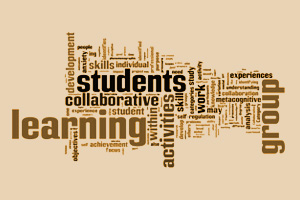
Learning together is collaborative learning. Learning does not take place so much in solitude as it takes place in the company of others. In fact learning together is both easier and more enjoyable. It s more productive as it is the result of interaction of more than one minds, personalities and opinions and gives us a chance to understand a concept from different perspectives. The advances in technology and changes in the organizational infrastructure put an increased emphasis on teamwork within the learning group.
Students are capable of performing at higher intellectual levels when asked to work in collaborative situations than when asked to work individually. Group diversity in terms of knowledge and experience contributes positively to the learning process. Cooperative learning methods improve problem- solving strategies because the students are confronted with different interpretations of the given situation. The peer support system makes it possible for the learner to internalize both external knowledge and critical thinking skills and to convert them into tools for intellectual functioning.
For collaborative learning to be effective, the instructor must view teaching as a process of developing and enhancing students’ ability to learn. The instructor’s role is not to transmit information, but to serve as a facilitator for learning. This involves creating and managing meaningful learning experiences and stimulating students’ thinking through real world problems.
If we consider collaborative learning in a broader sense, it should not be restricted to a group of students. Why can’t we have teachers and instructors collaborate with each other to bring a higher level of efficiency in our teaching? There can be several opportunities where collaboration of different subject areas may be desirable and effective. E.g. we can have a collaborative approach towards sex education involving the Biology teacher, the psychology teacher and the teacher of social science. This way the students will be exposed to different aspects of growth and reproduction . The biology and physical education teacher can collaborate in teaching the musculo-skeletal system with the biology teacher discussing the anatomy and physiology and the physical education teacher dealing with the aspect of sports related injuries and first aid. A physics and a geography teacher can come together to teach weather and climate to a learning group. A physics and biology teacher can join hands to teach the mechanism of hearing and working of the human eye. By working out a collaboration between teachers we can lay a deep foundation for a positive attitude towards lifelong learning through collaboration which entails listening to others, respecting others’ opinions, team work, reaching a consensus, critical analysis and a myriad of other skills.
When students see their teachers collaborating and sharing their knowledge, they will imbibe the same attitude. And this will lead to positive learning i.e. Learning together.
Teacher
Tripta Sablok
K.R. Mangalam World School Vikaspuri




Leave a Reply